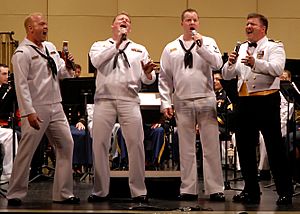Harmony facts for kids
Harmony in music means playing or singing different notes at the same time. When these notes sound good together, they form a chord. The word "harmony" comes from the ancient Greek word harmonia, which means "to join things together".
Imagine a simple tune. It sounds nice on its own. But when you add other notes or chords underneath it, the tune becomes richer. This process of adding chords to a tune is called harmonization. Musicians and students learn which chords sound good when played one after another. These sequences of chords are known as chord progressions. Many experts in music theory have written books to explain how harmony works.
Contents
Understanding Harmony in Music
When music has a main tune with chords supporting it, it's called homophonic music. Think of a pop song where a singer has the main melody, and instruments play chords behind them.
Homophony vs. Polyphony
Homophonic music is different from polyphonic music. In polyphonic music, several different tunes are played at the same time. Each part is a melody on its own. However, even in polyphonic music, these different melodies need to sound pleasant together. They still create harmony. Harmony, as we know it in European music, became fully developed during the Baroque period, which was in the 17th century.
How Chords are Built
You can create a basic chord using three notes. These notes are usually the 1st, 3rd, and 5th notes of the musical scale for that key. For example, in the key of C major, a basic chord uses C, E, and G. This type of chord often sounds like the "home" chord of the music.
Most homophonic music uses at least three notes for harmony. Often, there are four parts. For example, a choir usually divides into four vocal parts: soprano (highest female voice), alto (lower female voice), tenor (higher male voice), and bass (lowest male voice). A string quartet also has four parts: violin 1, violin 2, viola, and cello.
Types of Harmony
There are different ways to create harmony:
Tonal Harmony
Tonal harmony uses only the notes that belong to the main key of the music. For example, if a song is in C major, tonal harmony would mainly use the white notes on a piano.
Chromatic Harmony
Chromatic harmony adds extra notes that are not part of the main key. These notes often include sharps (♯) and flats (♭). This can make the music sound more colorful or dramatic.
Atonal Harmony
If music doesn't seem to be in any specific key at all, it's called atonal. Some composers, like Arnold Schoenberg, wrote atonal music. Harmony can also be atonal, meaning the chords don't follow traditional rules of key.
Images for kids
-
This picture shows how harmony can be suggested even with a single instrument. It's from J.S. Bach's Cello Suite no. 1 in G, BWV 1007, bars 1–2.
See also
 In Spanish: Armonía para niños
In Spanish: Armonía para niños


